India
Kochin
My next stop was Kochin, which is
mostly a resting place. Kochin is
near the southwestern tip of India,
and is made up of a set of islands,
strips of land and a large city
area. In fact, it is shaped just like
San Francisco bay. The main city area,
named Ernakulam, lies where Oakland or
Berkeley would be, and I ended up staying
at a resort 'palace' on one of the islands.
In fact, it is shaped just like
San Francisco bay. The main city area,
named Ernakulam, lies where Oakland or
Berkeley would be, and I ended up staying
at a resort 'palace' on one of the islands.
The place is called Boghatty Palace, a
former Dutch palace, now in renovation,
and I booked into a seaside cottage that
could only be described as 'just darling'.
The cottages are a big honeymoon place,
as well as a place for western visitors.
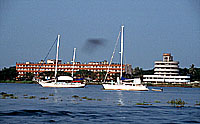
The Kochin area is hot and sticky, and for some reason, it really got to me. But I also noticed quite a discomfort in the natives also. And this is winter! I noticed that many women were carrying umbrellas, not for the rain, but for sun protection.
The men, like many men outside of the big cities, wear skirt-like outfits called dhotis, and often pick them up halfway up to the knees to make mini-skirts, as a mean to staying a little cooler.
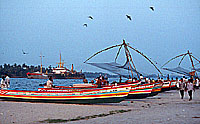 People live on the various islands and get
around by an excellent network of ferries
that cost at most 2 rupees, a ridiculously
low sum of money. One surprising feature in
Kochin, in contrast to most other Indian
cities that I've seen, is the number of women
visible around town, using the ferry and
bus system. This is one of a number of differences
that I've noticed in South India, as compared
to the north. Another big difference is that
it's a helluva lot cleaner than the north,
though the road systems is still awful, with
huge potholes that make traffic come to a
standstill. On the way from the airport to
the hotel, there was an accident near one of
these bad areas, and the heat and humidity
in the taxi was something awful.
People live on the various islands and get
around by an excellent network of ferries
that cost at most 2 rupees, a ridiculously
low sum of money. One surprising feature in
Kochin, in contrast to most other Indian
cities that I've seen, is the number of women
visible around town, using the ferry and
bus system. This is one of a number of differences
that I've noticed in South India, as compared
to the north. Another big difference is that
it's a helluva lot cleaner than the north,
though the road systems is still awful, with
huge potholes that make traffic come to a
standstill. On the way from the airport to
the hotel, there was an accident near one of
these bad areas, and the heat and humidity
in the taxi was something awful.
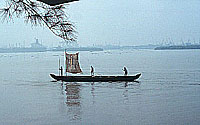 The island where I was staying, Boghatty island,
reminded me of the Fijian retreat facility of
my former teacher Adi Da/Love Ananda. It even
had the same frogs and land crabs (who live in
holes in ground and look like the creature in
Alien). Palm trees abound, and taking breakfast
under an umbrellad patio on the seashore, watching
the various ferries and cargo liners come to
and fro, was about a paradisical as it could
get.
The island where I was staying, Boghatty island,
reminded me of the Fijian retreat facility of
my former teacher Adi Da/Love Ananda. It even
had the same frogs and land crabs (who live in
holes in ground and look like the creature in
Alien). Palm trees abound, and taking breakfast
under an umbrellad patio on the seashore, watching
the various ferries and cargo liners come to
and fro, was about a paradisical as it could
get.
The Kerala Backwaters
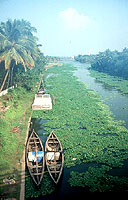 Kochin is in the Indian state called Kerala,
and the Kerala state tourism office offers
a most excellent tour of the backwater canals
that Kerala is famous for. There are several
tours, one last 4 hours and another 8 hours,
which is a one way trip to another city in
Kerala.
Kochin is in the Indian state called Kerala,
and the Kerala state tourism office offers
a most excellent tour of the backwater canals
that Kerala is famous for. There are several
tours, one last 4 hours and another 8 hours,
which is a one way trip to another city in
Kerala.
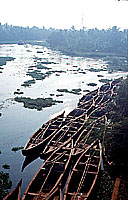 I booked the local 4 hour tour, which I shared
with 6 other people. We went in two cabs and
I shared a cab with Lawrence and his wife and
Fred. Lawrence and his wife are Indian, while
Fred is part Honduran and part Lebanese with
major good looks. He practically seduced the
Kerala tourist office worker right in front
of me. And it is always surprising to hear
an Indian with a western name - I've met
Johns and Lawrences and Marshalls and James,
which blows my mind a bit.
I booked the local 4 hour tour, which I shared
with 6 other people. We went in two cabs and
I shared a cab with Lawrence and his wife and
Fred. Lawrence and his wife are Indian, while
Fred is part Honduran and part Lebanese with
major good looks. He practically seduced the
Kerala tourist office worker right in front
of me. And it is always surprising to hear
an Indian with a western name - I've met
Johns and Lawrences and Marshalls and James,
which blows my mind a bit.
All three are Dutch KLM workers who get lots of super-cheap airfares and we got to be close very quickly. It's great to meet so many different people from various backgrounds and share an interesting experience.
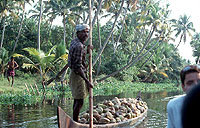 The tour started with a horrific taxi ride
to get to the canal area. The Ernakulam city
area is yet another traffic hellhole. Arriving
in a small town, we were ushered into two small
boats which are manuevered by a boatman with
a large bamboo pole, and he was quite adept
at it. He had a scripted spiel in broken English,
but by the end we all connected with him.
The tour started with a horrific taxi ride
to get to the canal area. The Ernakulam city
area is yet another traffic hellhole. Arriving
in a small town, we were ushered into two small
boats which are manuevered by a boatman with
a large bamboo pole, and he was quite adept
at it. He had a scripted spiel in broken English,
but by the end we all connected with him.
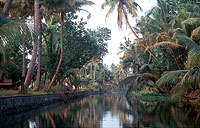 The tour was definitely a sightseeing highlight
of my journey. The man made canals are lined
with palm trees and small thatched-hut villages,
but while we were sailing along this paradisical
waterway, I couldn't help but think of the
movie Apocolypse Now, as the backwater canal
looked just like the one that Martin Sheen
travelled on in the movie. I could see in
my minds eye a set of US F-111 jets coming
in and dropping a few tonnage of bombs nearby.
Real sick thought, but that's what came up.
The tour was definitely a sightseeing highlight
of my journey. The man made canals are lined
with palm trees and small thatched-hut villages,
but while we were sailing along this paradisical
waterway, I couldn't help but think of the
movie Apocolypse Now, as the backwater canal
looked just like the one that Martin Sheen
travelled on in the movie. I could see in
my minds eye a set of US F-111 jets coming
in and dropping a few tonnage of bombs nearby.
Real sick thought, but that's what came up.
Basically, the people here thrive on coconuts. The entire tree is used, everything - the fiber is used to make rope and the trees are cut for dripping coconut oil, similar to maple syrup work. At one point our boatman stopped the boat on a levee and he tied a rope around his feet and proceeded to climb up a tree in lightning speed to get us fresh coconuts. Though this was not new to me (you can get fresh coconut juice in many cities), it is enjoyable to stick a straw into a coconut and sip the juice of a fresh fruit.
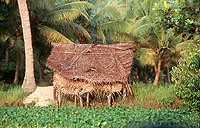 The people of the villages seemed very happy
and content, and I thought that these folks
are born and will live and die in these little
villages - so many different karmic destinies
in the world! I noticed a wild beauty to
these folks, as if the they're still in
touch with strong elemental forces of the
earth which shines out of their faces, especially
in the children. However, the kids can be
major moochers also, and ended up giving away
a lot of pens and candy, but got a few wonderful
pictures in return. But each village has its
temple, one of which was playing bhajan music
very loudly, disturbing the peace, in my opinion.
The people of the villages seemed very happy
and content, and I thought that these folks
are born and will live and die in these little
villages - so many different karmic destinies
in the world! I noticed a wild beauty to
these folks, as if the they're still in
touch with strong elemental forces of the
earth which shines out of their faces, especially
in the children. However, the kids can be
major moochers also, and ended up giving away
a lot of pens and candy, but got a few wonderful
pictures in return. But each village has its
temple, one of which was playing bhajan music
very loudly, disturbing the peace, in my opinion.
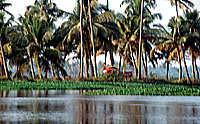 The tranquillity of this backwater area
penetrated me to the bone, to the point where
it seemed like a magical place, especially
as we watched the sunset over the rice
paddies and shrimp/prawn farms. First time
I've ever seen a live shrimp, damn ugly.
The day was also marked with the viewing
of the beautiful "fish eagle", a brown and
white bird that is somewhat similar to the
American bald eagle, which swoops down to
snag fish out of the waters. We saw the eagles
do this many times, which is the first time
I've ever seen something in person that I've
seen on the Discovery Channel. I tried my
hardest to catch one of these birds right
at the point of contact with the water with
my camera, and if so, I'll sell it to
National Geographic for thousands of dollars!
The tranquillity of this backwater area
penetrated me to the bone, to the point where
it seemed like a magical place, especially
as we watched the sunset over the rice
paddies and shrimp/prawn farms. First time
I've ever seen a live shrimp, damn ugly.
The day was also marked with the viewing
of the beautiful "fish eagle", a brown and
white bird that is somewhat similar to the
American bald eagle, which swoops down to
snag fish out of the waters. We saw the eagles
do this many times, which is the first time
I've ever seen something in person that I've
seen on the Discovery Channel. I tried my
hardest to catch one of these birds right
at the point of contact with the water with
my camera, and if so, I'll sell it to
National Geographic for thousands of dollars!
Fort Kochin and 'Jewtown'
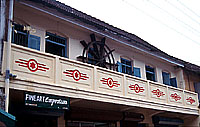 Fort Kochin is the 'old city' of Kochin,
and if you know San Francisco Bay, it would
be where San Francisco is. It is a peninsula
of land that has been zoned for only light
commercial business, and thus it is a quiet
and wonderful place to walk around for hours,
through the tiny streets. The people are
very friendly, some actually say hi without
trying to get rupees out of you!
Fort Kochin is the 'old city' of Kochin,
and if you know San Francisco Bay, it would
be where San Francisco is. It is a peninsula
of land that has been zoned for only light
commercial business, and thus it is a quiet
and wonderful place to walk around for hours,
through the tiny streets. The people are
very friendly, some actually say hi without
trying to get rupees out of you!
I also noticed that people of the South are well educated and most speak some level of English, having been taught in school. All the work learning Hindi for me is now out the window, as the native tongue is called Malayaam, which sounds like if you rolled your tongue indiscriminately and said "blublublublublub". The writing script is different than the north, constituting of what looks like a lot of curly 'm's and 'w's.
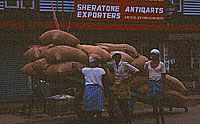 Fort Kochin has several interesting sights.
One is the "Dutch Palace", a former palace
now turned into a museum, which contains
some very remarkable wall murals or frescoes
of the various gods and goddesses of India.
The drawing style is unique, though some
of the mural were damaged by time. The
guidebook listed one must-see mural of
Lord Krishna having foreplay with 8 gopis
at once, using his 6 arms and two feet.
I'll leave out the details to the imagination,
but the mural really captured the rapture
of the gopis. I always wondered why the
gods and goddess of India had multiple
arms, and now, aha! (Of course, Krishna
is the god of love, and other multi-armed
gods and goddesses use their arms to slay
multiple enemies at once).
Fort Kochin has several interesting sights.
One is the "Dutch Palace", a former palace
now turned into a museum, which contains
some very remarkable wall murals or frescoes
of the various gods and goddesses of India.
The drawing style is unique, though some
of the mural were damaged by time. The
guidebook listed one must-see mural of
Lord Krishna having foreplay with 8 gopis
at once, using his 6 arms and two feet.
I'll leave out the details to the imagination,
but the mural really captured the rapture
of the gopis. I always wondered why the
gods and goddess of India had multiple
arms, and now, aha! (Of course, Krishna
is the god of love, and other multi-armed
gods and goddesses use their arms to slay
multiple enemies at once).
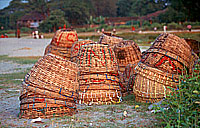 I spent one whole day walking through town -
one section of town holds numerous spice
warehouses (remember Christopher Columbus and
the 'Spice Islands'? - that's Kochin!), which
made Kochin the best smelling city in India.
I was accosted by one point by several children
asking for pens, which I gladly handed out,
and I had them all pose for a picture. They
were so damn cute! I noticed that Fort Kochin
is chock full of handicraft shops and made a
few purchase, and while breaking for a 7-Up
(it's here too, with Coke and Pepsi), I struck
up a conversation with a Brit named Gary. I
tried to guess where he was from in England -
I could tell he was from the north - I said
Birmingham? and he said no, Liverpool. He's
too young to personally know any of the Fab 4.
I spent one whole day walking through town -
one section of town holds numerous spice
warehouses (remember Christopher Columbus and
the 'Spice Islands'? - that's Kochin!), which
made Kochin the best smelling city in India.
I was accosted by one point by several children
asking for pens, which I gladly handed out,
and I had them all pose for a picture. They
were so damn cute! I noticed that Fort Kochin
is chock full of handicraft shops and made a
few purchase, and while breaking for a 7-Up
(it's here too, with Coke and Pepsi), I struck
up a conversation with a Brit named Gary. I
tried to guess where he was from in England -
I could tell he was from the north - I said
Birmingham? and he said no, Liverpool. He's
too young to personally know any of the Fab 4.
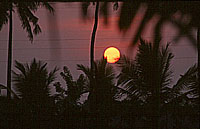 But we did end up having a long, long dharma
talk way into the evening. He belongs to a
group known as the Western Buddhist Order,
based on a teacher of British origin who wandered
India for 30 years before starting the order.
I thought what he had to say made a lot of
sense, they had a strong belief in stages in
the spiritual process, but differed from
the Tibetan approach. I bought the fellow dinner,
and when we bid goodnight, I again went through
the ordeal of three ferries to my cottage on
Boghatty Island.
But we did end up having a long, long dharma
talk way into the evening. He belongs to a
group known as the Western Buddhist Order,
based on a teacher of British origin who wandered
India for 30 years before starting the order.
I thought what he had to say made a lot of
sense, they had a strong belief in stages in
the spiritual process, but differed from
the Tibetan approach. I bought the fellow dinner,
and when we bid goodnight, I again went through
the ordeal of three ferries to my cottage on
Boghatty Island.
 Back |
 Next, Madras |
|
|
Page 12. |
||
